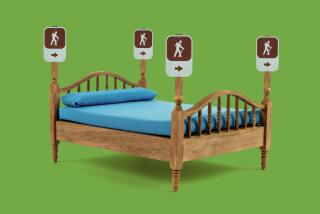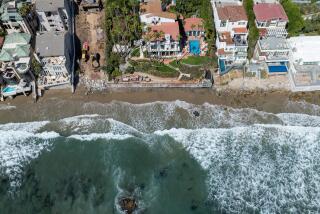THE TIMES ORANGE COUNTY POLL : It’s the Villages That Tell the Newport Beach Story : Loyalties: Patchwork of distinct communities gives small-town feel to Orange County’s 12th largest city.
- Share via
NEWPORT BEACH — When architects recently showed their plans for a new fire station to the residents of Balboa Island, there was a quick complaint about the words over the door: City of Newport Beach.
It’s not that they don’t like Newport Beach. It’s just that for them, the town is called Balboa Island.
“You ask someone where they live, and they don’t say Newport Beach, they say Eastbluff or Harbor Ridge . . . ,” explained Jim Felton, a historian and journalist who has written about the city for decades. “Since the places were built, areas have evolved their own character and personality by the people who moved there. They’re provincial about their separate parts of town.”
Residents say one of the things that separates Newport Beach from other cities is its patchwork of distinct communities. The villages give a small-town feel to life in Orange County’s 12th largest city. And to many residents, allegiance to their community is a passion.
At a recent City Council meeting, the mayor presented souvenir T-shirts from the city’s Corona del Mar section to a delegation from Newport Beach’s sister city in Japan.
“Make sure you tell them those are from the most important part of the city,” called out Phil Sansone, who represents the seaside neighborhood on the seven-member council.
“Finally, you admit it’s part of the city,” quipped his colleague, Evelyn R. Hart.
The development of the villages dates back to the city’s early days. Each community established its identity with separate convenience stores and movie theaters within walking distance.
Geography has kept many of the enclaves distinct. Several are located on islands in the city’s large harbor. Others are bordered by canyons and high rolling hills. In the newer sections of town, communities are enclosed by guarded gates.
With fewer than 70,000 residents, Newport Beach today is splintered into more than 100 homeowners’ associations--representing as few as eight homes.
But the city’s approval of its divided villages was reflected in a recent Times Orange County Poll that contacted 600 adult residents of Newport Beach over a three-day period ending Jan. 30.
More than 70% in the survey said they are “very satisfied” with their neighbors and the city’s social life. An additional 25% said they are somewhat satisfied and only 3% say they are not satisfied.
Asked what they like best about living in Newport Beach, 7% said it is the neighbors.
“In the old days, when people started coming down to Newport Beach, people encouraged their friends to rent a house on the same block or in the same area, and those areas took on a certain character,” said Bill Ficker, an architect who moved to the city in 1953.
“You came down here and you were planted in your community, that’s where you stayed,” Ficker said. “The neighborhoods didn’t sprawl into each other. You didn’t say you lived on the corner of such and such, you said you lived in whichever village.”
Those identities remain today--from the vacation land that is Balboa Island to quaint, old-fashioned Corona del Mar; from crowded, noisy West Newport to pristine, exclusive Spyglass Hill; from the golf course of Big Canyon to the fancy shores of Linda Isle.
Corona del Mar is tucked into the coastal bluffs at the mouth of Newport Bay. Though it has been part of Newport Beach since 1926, the village retains its own Chamber of Commerce and a welcome to Corona del Mar sign is posted at the border of the community. Residents also boast about their own post office, their own library and even a freeway sign bearing the neighborhood’s name.
Luvena Hayton, who was recently crowned First Lady of Corona del Mar, said the small-town atmosphere makes Corona del Mar special.
“Newport is rather spread out, we are a little more concise,” said Hayton, who moved to the village in 1950 and has owned a clothing store on Coast Highway for years. “We are an entity unto ourselves.”
Many of the pastel cottages and beach bungalows that made Corona del Mar quaint have been replaced by townhouses and elaborate mansions. But old-fashioned street lights and community projects--such as the current plan to decorate each street with flowers to match its name--are designed to maintain the village identity.
“It still has the ambience and feeling of a small town,” Hayton said. “We try to keep it that way.”
On the other side of the bay’s stone jetties are eight islands, seven created by harbor dredging in the 1920s.
The most populous and the most famous is Balboa, where about 4,500 residents live in 2,000 homes and visitors by the thousands flock each summer weekend. Balboa is also the only island with a commercial strip and the only one with a public walkway encircling it.
“I’ve traveled around the world, (and) I’m not exaggerating, there’s no other place like it anywhere in the world, including other places in Newport Beach,” said Ralph Rodheim, president of the Balboa Island Improvement Assn. “Someone who wants privacy and seclusion would live on Lido or one of the others. Someone who’s more outgoing would choose Balboa.”
Balboa Island traditions include the daily early-morning gathering of business leaders at Dad’s Donuts; the 30-foot Christmas tree in front of Hershey’s Market and free movies shown outdoors each Thursday evening during the summer.
One of the city’s most famous attractions is also the Balboa Island ferry, run since 1906 by the same family. The ferry transports people and cars on a quick trip across the harbor to Balboa Peninsula for just 25 cents a person and 65 cents per motorist.
Balboa Island is actually divided into three islands separated by small canals. Across the “Grand Canal” is Little Balboa Island. At the other end is minuscule Collins Island, an enclave of eight homes where the main responsibility of the informal mayor, Jackie Thomason, is to tend the garden and oil the gate.
Across the bay is triangle-shaped Lido Isle, designed after a beach in Venice, Italy, “where the elite and fashionable of Continental Europe forgather to introduce styles and fashion in beach sport costumes,” according to a 1930s promotional brochure.
Life on Lido centers at the clubhouse, with a private beach, tennis courts, and picnic areas for the island’s 850 families. Bought from the Pacific Electric Co. in 1923 for $45,000, Lido Isle was once home to celebrities Candice Bergen, Jane Wyman and Johnnie Mercer. Now, the area is a family-oriented suburb where homes range from $350,000 to $7 million.
Between Balboa and Lido sit three small, exclusive islands closed to the public--Linda, Harbor and Bay Islands.
Linda Isle was the setting for the 1949 John Wayne classic “Sands of Iwo Jima” before it was developed. Now it is home to Orange County’s only billionaire, Irvine Co. Chairman Donald L. Bren. The island is shaped like a horseshoe, so each home has waterfront property.
Harbor Island, which can be crossed on foot in 15 minutes, was once home to violinist Jascha Heifetz and then banker H.F. Ahmanson. Foot-for-foot, experts say it may be the priciest enclave in Orange County.
Nearby is Bay Island, another tiny patch crowded with 24 housing lots. No cars are allowed on Bay Island and residents must vote to accept a new neighbor before a home purchase is allowed.
The low-rent section of the harbor is Newport Island, squeezed between Balboa Boulevard and Coast Highway with just a thin stream of water around it. On Newport Island, real estate is cheaper and, as one longtime resident explained, “most people work.”
Here, pickup trucks and big American-made sedans are parked next to Mercedeses and BMWs. “It’s quiet, it’s off the beaten path,” said Dana Carl, 43. “A lot of people don’t know it’s over this way.”
The quiet seclusion of the city’s islands contrasts with the nearby sections of West Newport and Balboa Peninsula. Both are busy neighborhoods where crowds gather all summer long.
A dense row of duplexes stretching from the city’s border to the Newport Pier, West Newport has the highest concentration of renters in the city and the highest rate of both petty and serious crimes. A city committee is currently drafting a plan to overhaul the neighborhood and make it more stable.
With the Fun Zone as its flagship lure, the Balboa Peninsula remains a hot tourist spot as well as a tight-knit community. Glorious estates sit on the water while college students and young professionals rent bungalows nearby.
Traffic is congested, so most residents walk the streets.
“You don’t feel like you’re living in Forest Lawn on the Balboa Peninsula, (that’s) for sure,” said Ficker, the architect who has called the place home for four decades. “It’s not an isolated community. You feel like you’re part of the activity all the time. There’s a unique fabric to the community.”
But even here, apparently, one can’t fight City Hall. The sign over the door of the Balboa Island firehouse will still read City of Newport Beach.
How the Poll Was Conducted
The Times Orange County Poll was conducted by Mark Baldassare & Associates. The telephone survey of 600 Newport Beach adult residents was conducted Jan. 27 to 30 on weekday nights and weekend days. A computer-generated random sample of telephone numbers was used. Interviews were conducted in English and Spanish as needed. The margin of error for the total sample is plus or minus 4% at the 95% confidence level. That means it is 95% certain that the results are within 4 percentage points of what they would be if every Newport Beach resident were interviewed. For subgroups, such as upper-income Newport Beach residents, the margin of error would be larger.
More to Read
Sign up for Essential California
The most important California stories and recommendations in your inbox every morning.
You may occasionally receive promotional content from the Los Angeles Times.










